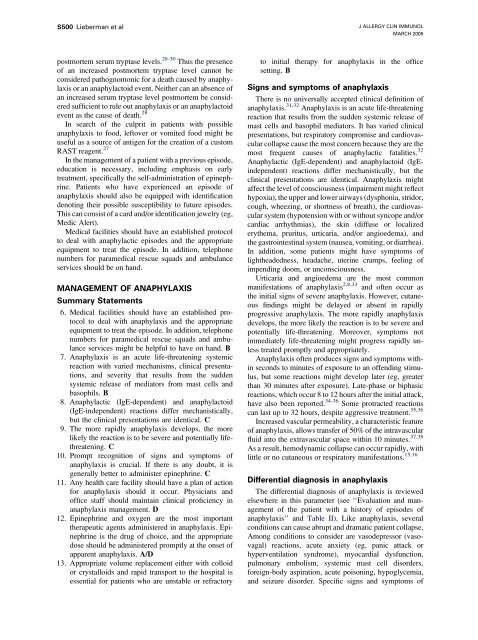Immunotherapy Safety for the Primary Care ... - U.S. Coast Guard
Immunotherapy Safety for the Primary Care ... - U.S. Coast Guard
Immunotherapy Safety for the Primary Care ... - U.S. Coast Guard
You also want an ePaper? Increase the reach of your titles
YUMPU automatically turns print PDFs into web optimized ePapers that Google loves.
S500 Lieberman et al<br />
J ALLERGY CLIN IMMUNOL<br />
MARCH 2005<br />
postmortem serum tryptase levels. 28-30 Thus <strong>the</strong> presence<br />
of an increased postmortem tryptase level cannot be<br />
considered pathognomonic <strong>for</strong> a death caused by anaphylaxis<br />
or an anaphylactoid event. Nei<strong>the</strong>r can an absence of<br />
an increased serum tryptase level postmortem be considered<br />
sufficient to rule out anaphylaxis or an anaphylactoid<br />
event as <strong>the</strong> cause of death. 28<br />
In search of <strong>the</strong> culprit in patients with possible<br />
anaphylaxis to food, leftover or vomited food might be<br />
useful as a source of antigen <strong>for</strong> <strong>the</strong> creation of a custom<br />
RAST reagent. 27<br />
In <strong>the</strong> management of a patient with a previous episode,<br />
education is necessary, including emphasis on early<br />
treatment, specifically <strong>the</strong> self-administration of epinephrine.<br />
Patients who have experienced an episode of<br />
anaphylaxis should also be equipped with identification<br />
denoting <strong>the</strong>ir possible susceptibility to future episodes.<br />
This can consist of a card and/or identification jewelry (eg,<br />
Medic Alert).<br />
Medical facilities should have an established protocol<br />
to deal with anaphylactic episodes and <strong>the</strong> appropriate<br />
equipment to treat <strong>the</strong> episode. In addition, telephone<br />
numbers <strong>for</strong> paramedical rescue squads and ambulance<br />
services should be on hand.<br />
MANAGEMENT OF ANAPHYLAXIS<br />
Summary Statements<br />
6. Medical facilities should have an established protocol<br />
to deal with anaphylaxis and <strong>the</strong> appropriate<br />
equipment to treat <strong>the</strong> episode. In addition, telephone<br />
numbers <strong>for</strong> paramedical rescue squads and ambulance<br />
services might be helpful to have on hand. B<br />
7. Anaphylaxis is an acute life-threatening systemic<br />
reaction with varied mechanisms, clinical presentations,<br />
and severity that results from <strong>the</strong> sudden<br />
systemic release of mediators from mast cells and<br />
basophils. B<br />
8. Anaphylactic (IgE-dependent) and anaphylactoid<br />
(IgE-independent) reactions differ mechanistically,<br />
but <strong>the</strong> clinical presentations are identical. C<br />
9. The more rapidly anaphylaxis develops, <strong>the</strong> more<br />
likely <strong>the</strong> reaction is to be severe and potentially lifethreatening.<br />
C<br />
10. Prompt recognition of signs and symptoms of<br />
anaphylaxis is crucial. If <strong>the</strong>re is any doubt, it is<br />
generally better to administer epinephrine. C<br />
11. Any health care facility should have a plan of action<br />
<strong>for</strong> anaphylaxis should it occur. Physicians and<br />
office staff should maintain clinical proficiency in<br />
anaphylaxis management. D<br />
12. Epinephrine and oxygen are <strong>the</strong> most important<br />
<strong>the</strong>rapeutic agents administered in anaphylaxis. Epinephrine<br />
is <strong>the</strong> drug of choice, and <strong>the</strong> appropriate<br />
dose should be administered promptly at <strong>the</strong> onset of<br />
apparent anaphylaxis. A/D<br />
13. Appropriate volume replacement ei<strong>the</strong>r with colloid<br />
or crystalloids and rapid transport to <strong>the</strong> hospital is<br />
essential <strong>for</strong> patients who are unstable or refractory<br />
to initial <strong>the</strong>rapy <strong>for</strong> anaphylaxis in <strong>the</strong> office<br />
setting. B<br />
Signs and symptoms of anaphylaxis<br />
There is no universally accepted clinical definition of<br />
anaphylaxis. 31,32 Anaphylaxis is an acute life-threatening<br />
reaction that results from <strong>the</strong> sudden systemic release of<br />
mast cells and basophil mediators. It has varied clinical<br />
presentations, but respiratory compromise and cardiovascular<br />
collapse cause <strong>the</strong> most concern because <strong>the</strong>y are <strong>the</strong><br />
most frequent causes of anaphylactic fatalities. 32<br />
Anaphylactic (IgE-dependent) and anaphylactoid (IgEindependent)<br />
reactions differ mechanistically, but <strong>the</strong><br />
clinical presentations are identical. Anaphylaxis might<br />
affect <strong>the</strong> level of consciousness (impairment might reflect<br />
hypoxia), <strong>the</strong> upper and lower airways (dysphonia, stridor,<br />
cough, wheezing, or shortness of breath), <strong>the</strong> cardiovascular<br />
system (hypotension with or without syncope and/or<br />
cardiac arrhythmias), <strong>the</strong> skin (diffuse or localized<br />
ery<strong>the</strong>ma, pruritus, urticaria, and/or angioedema), and<br />
<strong>the</strong> gastrointestinal system (nausea, vomiting, or diarrhea).<br />
In addition, some patients might have symptoms of<br />
ligh<strong>the</strong>adedness, headache, uterine cramps, feeling of<br />
impending doom, or unconsciousness.<br />
Urticaria and angioedema are <strong>the</strong> most common<br />
manifestations of anaphylaxis 2,8,33 and often occur as<br />
<strong>the</strong> initial signs of severe anaphylaxis. However, cutaneous<br />
findings might be delayed or absent in rapidly<br />
progressive anaphylaxis. The more rapidly anaphylaxis<br />
develops, <strong>the</strong> more likely <strong>the</strong> reaction is to be severe and<br />
potentially life-threatening. Moreover, symptoms not<br />
immediately life-threatening might progress rapidly unless<br />
treated promptly and appropriately.<br />
Anaphylaxis often produces signs and symptoms within<br />
seconds to minutes of exposure to an offending stimulus,<br />
but some reactions might develop later (eg, greater<br />
than 30 minutes after exposure). Late-phase or biphasic<br />
reactions, which occur 8 to 12 hours after <strong>the</strong> initial attack,<br />
have also been reported. 34-36 Some protracted reactions<br />
can last up to 32 hours, despite aggressive treatment. 35,36<br />
Increased vascular permeability, a characteristic feature<br />
of anaphylaxis, allows transfer of 50% of <strong>the</strong> intravascular<br />
fluid into <strong>the</strong> extravascular space within 10 minutes. 37,38<br />
As a result, hemodynamic collapse can occur rapidly, with<br />
little or no cutaneous or respiratory manifestations. 15,16<br />
Differential diagnosis in anaphylaxis<br />
The differential diagnosis of anaphylaxis is reviewed<br />
elsewhere in this parameter (see ‘‘Evaluation and management<br />
of <strong>the</strong> patient with a history of episodes of<br />
anaphylaxis’’ and Table II). Like anaphylaxis, several<br />
conditions can cause abrupt and dramatic patient collapse.<br />
Among conditions to consider are vasodepressor (vasovagal)<br />
reactions, acute anxiety (eg, panic attack or<br />
hyperventilation syndrome), myocardial dysfunction,<br />
pulmonary embolism, systemic mast cell disorders,<br />
<strong>for</strong>eign-body aspiration, acute poisoning, hypoglycemia,<br />
and seizure disorder. Specific signs and symptoms of
















